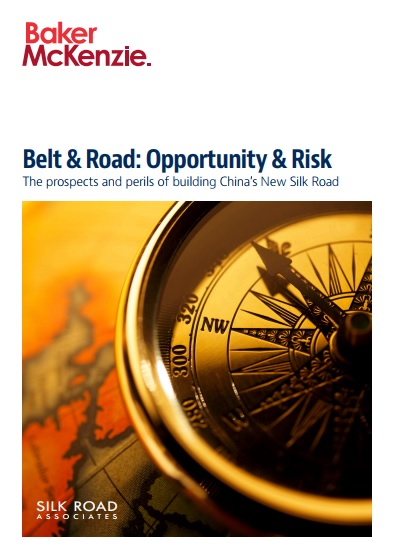(24 October 2017, Hong Kong) China’s Belt and Road Initiative (BRI) is stepping up a gear, with new BRI-related projects estimated to be worth US $350 billion* over the next five years. This is according to a new report by Baker McKenzie and Silk Road Associates; Belt & Road: Opportunities & Risks. The prospects and perils of building China’s New Silk Road.
Outside of China, just 10 markets (out of more than 60) account for two thirds of BRI GDP, and are predicted to offer significant new commercial opportunities for local and foreign partners in the next five years. Those markets are India, Indonesia, Iran, Korea, Poland, Russia, Saudi Arabia, Taiwan, Thailand and Turkey.
While BRI (also know as OBOR) is primarily divided between the overland ‘Belt’, the classically defined Silk Road that stretches from China to Europe, and the new, maritime Silk Road, that covers much of Asia, the Middle East and Eastern Africa, there are actually six different BRI trade corridors developing at present, which collectively cover 69% of the world’s population and 51% of its GDP.
Chinese government data indicate that 50 Chinese SOEs have already invested or participated in nearly 1700 projects in Belt and Road countries since the initiative was launched three years ago. This number is set to grow significantly in the next five years, particularly as private Chinese interests and international partners begin to invest in the wake of these SOEs.
Ben Simpfendorfer, Founder and CEO of Silk Road Associates, said: “A tangible shift in Chinese commercial activity in the BRI region over the past six months should now leave no doubt about China’s intention to see BRI become a defining force in the global economic landscape, for decades to come.”
While infrastructure development has been the primary driver of BRI activity to date, this new report identifies sectors including technology and telecommunications, manufacturing and eventually consumer goods and retail as all starting to play a larger role in BRI over the next five years and beyond.
The report encourages companies to begin exploring BRI opportunities on offer now, while international partners are being widely sought by Chinese investors.
Stanley Jia, Chief Representative of Baker McKenzie’s Beijing office, said: “While BRI was seen at its inception as predominantly the preserve of Chinese SOEs, funded by Chinese banks, and staffed by Chinese workers, the sheer scale and ambition of the initiative means there will be plentiful opportunities for those local and multinational companies that can work hand in hand with Chinese organisations for mutual benefit, particularly as the next wave of Chinese investment arrives.”
BRI is also not without risk for those companies that are investing in and working on BRI projects. Those risks include foreign investment restrictions, antitrust regulations, tax, local employment and environmental laws, as well as political risks in some jurisdictions.
Baker McKenzie is uniquely placed to support organisations with BRI ambitions, with an on the ground presence in more countries than any other law firm along the Belt, and the Road.













